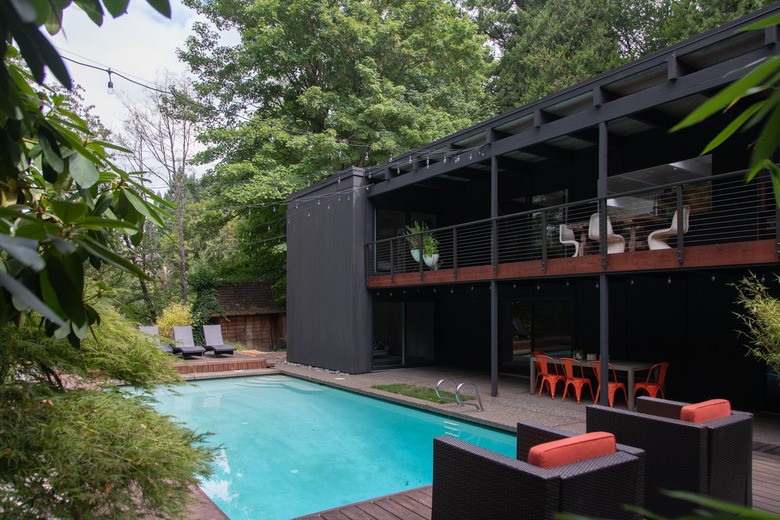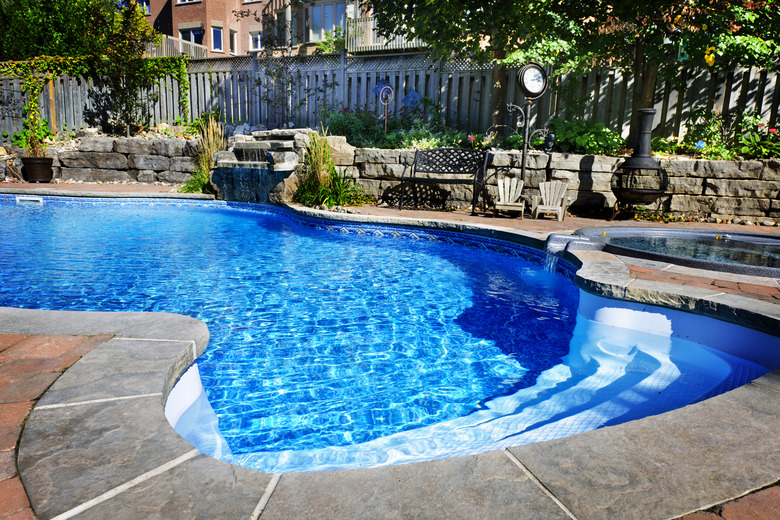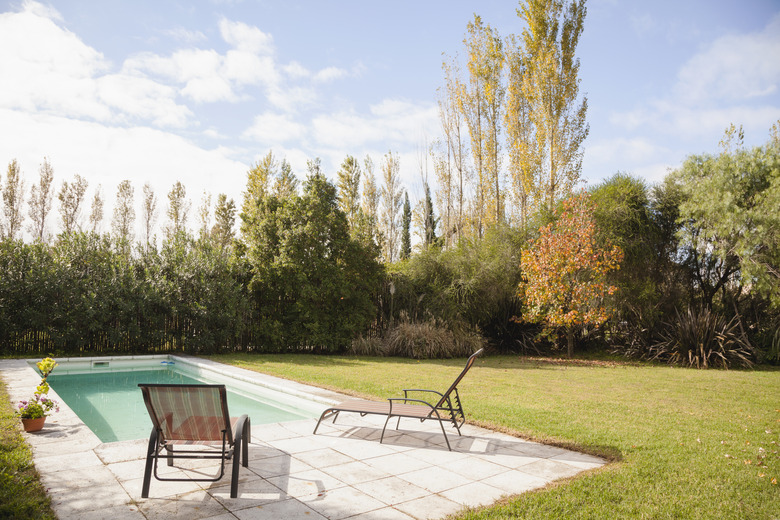A Beginner's Guide To Swimming Pool Cleaning And Maintenance
We may receive a commission on purchases made from links.
A good way to approach swimming pool maintenance is to compare the pool to your own cardiovascular system. The lifeblood of the pool's system is water, and to maintain the health of the pool and everyone who uses it, the water has to be continuously circulated, which is the job of the pool pump — the heart of the system — and purified, which is the job of the filtration system — your pool's liver. The water also has to have the right balance of pool chemicals to control the growth of pathogens and prevent disease.
Cardiovascular problems in humans have a number of causes, such as clogged veins and arteries, which make the heart work harder and thus wear it out prematurely. Chemical imbalances overload the liver and impair its ability to filter, which makes the problem even worse. The result is a loss of vital energy, often accompanied by a sickly pallor. The same thing can happen to swimming pool water, which often turns green or brown and becomes cloudy when it's full of algae, bacteria and other pathogens.
When you perform pool maintenance, you're basically acting as the pool's doctor, and many pool professionals recognize this and give their businesses names like "Pool Doctor" or "Pool Clinic." Like any good doctor, you have to keep a close eye on your patient and address problems as soon as they arise to prevent them from turning into bigger problems. This isn't as hard to do as it sounds, and if you stay on top of the situation, your pool will reward you with refreshingly clean and clear water and a healthy swimming experience.
Checking and Maintaining Chlorine Levels
Checking and Maintaining Chlorine Levels
In the human body, a collection of white blood cells and antibodies fight pathogens that cause disease, but in a conventional swimming pool, chlorine does this job. It is either introduced directly into the water as sodium hypochlorite or generated from saltwater by a chlorine generator, and maintaining the proper level of this sanitizing chemical is paramount. If the level is too low, no sanitization occurs, and if it's too high, the water is unhealthy for swimming. The ideal chlorine level is between 1.0 and 3.0 parts per million (ppm).
Every pool maintenance kit contains a chemical or a test strip for testing chlorine levels, and because the testing method varies according to the kit, it's important to read the instructions. Typically, you add some of the testing chemical o a sample of the pool water or dip the test strip in the water, note the color and consult a color chart to determine the chlorine level. You should do this job daily or weekly depending on pool usage, but you should always do it after a heavy rainstorm or heavy pool usage or when the pool smells like chlorine, which are all times when chlorine levels tend to be low.
You can chlorinate the pool water in one of three ways. You can add granular chlorine by dissolving it in a bucket of pool water and pouring the water in the pool, or you can pour liquid chlorine (such as chlorine bleach) directly into the pool. You can also use chlorine tablets, which gradually release chlorine into the water. Chlorine quickly becomes unavailable in the sun. To prevent this, you have to add a stabilizer unless the chlorinating product you use includes one.
More Pool Chemistry: pH and Total Alkalinity
More Pool Chemistry: pH and Total Alkalinity
It's important to monitor two other chemical characteristics of swimming pool water on a weekly basis: pH and total alkalinity. They determine the effectiveness of the sanitizer and the formation of scale and other contaminants that turn the water cloudy and leave deposits on the pool filter. The pH level determines the acidity or alkalinity of the water, and it's measured on a scale of 0 to 14, with low levels indicating acidic water and high levels indicating alkaline water. The ideal pool pH is between 7.2 and 7.6, which is just on the alkaline side of neutral.
Total alkalinity sounds redundant, but it's actually a measurement of how much alkaline material is dissolved in the water, and it's measured in parts per million (ppm). The higher the total alkalinity, the more resistance the water has to changes in pH, but if the total alkalinity is too high, mineral deposits are more likely to form. The ideal range is between 80 and 120 ppm. A test kit for total alkalinity usually consists of an acid that you add to a premeasured sample of pool water.
When the pool water turns cloudy or starts to smell like chlorine, the cause is often low pH because acidic water reduces the amount of available chlorine and increases the concentration of odorous chloramines. Before you add more chlorine to the pool, you should raise the pH by adding either baking soda or soda ash depending on the total alkalinity level. If that's already high, use soda ash, which has less effect on total alkalinity than baking soda. The water can also get cloudy when the pH is too high because of excess minerals, and you can lower it with a pH reducer, which often contains muriatic acid or sodium bisulfate.
Pool Maintenance: The Filter System
Pool Maintenance: The Filter System
Just as your liver filters impurities out of your bloodstream, your pool's filter screens out debris that discolors the pool water and can make it unappealing and unsafe, and it protects the pump, which should need little maintenance if the filter system is working. The filtration system includes at least one skimmer (usually more), the filter itself and the tubing that connects them. The filtering media may be sand, diatomaceous earth or a combination of filtering materials enclosed inside a cartridge, and part of pool maintenance is keeping it clean.
The skimmers are the filter system's first line of defense and need to be checked and cleaned frequently. A good strategy is to check them whenever you measure the pH and chlorine levels. The filter itself needs cleaning far less frequently — usually no more than twice a year — but if the pressure gauge shows 10 or more psi over the normal reading or the pool water is cloudy, the filter is overdue for cleaning.
The actual cleaning method depends on the type of filter you have, and you should consult the manufacturer's instructions for guidance. You can backwash sand and diatomaceous earth filter systems, but if you have a cartridge filter, you usually have to disassemble it and clean the parts with a garden hose. If backwashing or cleaning the filter does not resolve cloudiness or pressure issues, it's time to replace the media or the cartridge, and you'll probably have to do this at two- to three-year intervals depending on how much you use the pool.
More on Keeping the Pool Water Clean
More on Keeping the Pool Water Clean
An open body of water is a magnet for all sorts of debris, including leaves, acorns, pine needles and airborne pollution in general. You have to clean the pool regularly to keep it out of the filtration system and keep the pool and the pool water sterile. If you have an above-ground pool or a very small in-ground one, the best way to do this is to use a handheld pool vacuum. Vacuuming can be a time-consuming job if you have a large pool, though, so you might want to invest in a robotic vacuum that scours the bottom of the pool continuously. Depending on the model, it may even clean the sides, leaving you free to do other things.
The pool water itself inevitably develops a film of oily residue from sunscreen and cosmetics left behind by swimmers, and because it's on the surface, it doesn't always get pulled through the filtration system. An easy way to deal with it is to drop a few brand-new tennis balls into the water. They will float on the surface and collect the oils, and when they get dirty, you can replace them with new ones and use the soiled ones on the tennis court. It also helps to make the skimmers more efficient by stretching nylon pantyhose across them and discarding them when they get clogged with oils.
Keep an eye on the pool liner while you're vacuuming the pool or checking chemical levels. If you have an above-ground pool with a vinyl liner, check it for pinholes or small tears, which will make themselves known by a slowly receding water level in the pool. If you have a fiberglass, concrete or gunite in-ground pool, check the walls for small cracks that could turn into big ones if left to do so.
Shocking the Swimming Pool Water
Shocking the Swimming Pool Water
Even if you work assiduously to monitor and adjust the chlorine levels, pH and total alkalinity, the water can turn cloudy or begin to smell like chlorine, which means it's full of chloramines and is deficient in free chlorine. This can happen for reasons largely out of your control, such as a heavy rainstorm followed by days of hot, sunny weather, and when it does happen, you usually have to shock the pool water by introducing a large amount of sanitizing agent at once. Because ultraviolet sunlight breaks down chlorine quickly, the best time to shock a pool is in the early evening after the sun has set so the chlorine has all night to work. As an alternative, you can use a pool-shock product that contains a stabilizer.
You can shock a pool with a sodium hypochlorite solution, but it's usually better to use a pool-shock product containing calcium hypochlorite, which is more effective for killing bacteria and algae that turn the pool water green or brown. If you have a saltwater pool, however, it's better to stick to sodium hypochlorite because calcium hypochlorite increases the mineral content of the water and promotes the growth of scale, and a saltwater pool is already high in minerals. Because it adds calcium to the water, calcium hypochlorite should never be used for routine chlorination of any pool, saltwater or not.
Always check the pH and total alkalinity to make sure they are in the proper ranges (between 7.2 and 7.6 and 80 to 120 ppm, respectively) before introducing pool shock, or the chlorine you add won't have the expected effect. If the pool has severe algae growth, you may have to double or triple the shock by using twice or three times the amount of product recommended for a single shock. Shocking raises the chlorine level far beyond what is safe for swimming, so it's important to keep everyone out of the pool until the chlorine level has fallen to 3 ppm.


